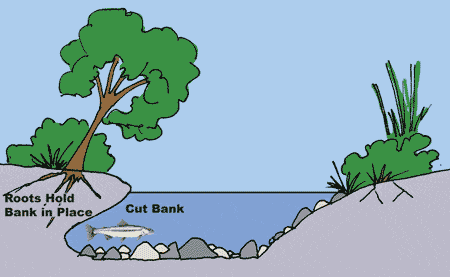By Amy Barouth, volunteer
Every year, we ask volunteers to plant trees along the Red River and that is because trees play a large role in the health of a river system and a community. There are many reasons why that is the case.
Rivers are dynamic. They meander and sometimes cut new pathways altogether. Cut banks are the outer banks of an s-curve in the river where the water flows faster. On the more protected inner part of the river’s s-curve the water slows down, and sediments drop from the water creating a point bar. In open plains, this process is what allows rivers to move their banks. That is where tree roots come in to hold the bank together.

Riverside trees serve an especially important bank stabilizing role in the Red River Valley since it is made up of soft clay soils left behind by a giant glacial lake. These clays are structurally weak and when saturated, are prone to slumping into the river. Weight such as that of buildings, septic systems or roadways or having shallow-rooted turf grass on the riverbank further magnifies the situation. Enter trees, and all the other riparian plants with a full variety of root depths, but especially trees with their thick and expansive roots. The root systems of trees not only stabilize river banks structurally, they also take in large quantities of water, lessening the saturation of the clay soils.
There are many more benefits that riparian (the area next to the river) trees provide. Banks stabilized by tree roots are protecting water quality since eroded soil itself can become a river pollutant. Forested river banks filter much of the water that runs off our urban and agricultural landscapes, slowing polluted overland flows by allowing the water to soak into the soil. Tree-provided shade keeps river water temperatures cooler (Fun fact: Oxygen dissolves better in cooler water, and that is important for fish species). The trees, along with other plant varieties, also form habitat for wildlife. Even the fallen trees, called snags, serve to create habitat and slow water flows.
If you’d like to plant a few trees along the Red River, volunteer for one of the Reforest the Red events, we have thousands of trees and shrubs to plant in 2019! This is a great chance to gather your family, friends or associates to make a positive difference together. Or, come on your own and meet some fellow tree-loving friends of the river. Go to https://docs.google.com/forms/d/e/1FAIpQLSe1kKS1DuWuofM8uAKjUJ0IYxWyxcjJT_DgNuaICDXDVEcK5w/viewform?vc=0&c=0&w=1 to sign up, or call Kim Morris at (701) 356-8915. We ask that at least one adult is present for every five kids (K thru 8th grade).
- On June 7th, from 1 – 4:30 p.m. we partner with the City of Moorhead and the Clay County Soil and Water Conservation District at River Oaks Park. Short training sessions will be held throughout the event. Subs and water served while supplies last.
- On September 11th, from 12 – 7 p.m. we partner with the City of Fargo, Fargo Park District and Cass County Soil Conservation District at Trollwood Park. Short trainings will be held throughout the event. Hot dogs will be served from 1-3pm and 5-7pm while supplies last. Water served all day while supplies last.

Photo Credit: Jack Anderson
